|
|
Post by barbhorses on Jun 7, 2009 10:42:42 GMT -5
Dino is a very pretty bay... I still don't see any dun factor on him. Black stockings and rimmed ears are all part of what the bay color entails and of course with black mane and tail. Do you have pictures of him showing a clear, dark dorsal?
|
|
|
|
Post by barbhorses on Jun 7, 2009 11:03:14 GMT -5
|
|
|
|
Post by barbhorses on Jun 7, 2009 11:23:55 GMT -5
Well, I was looking through your blog and found a hind pic of Dino. He is definitely a bay. No hint of dilution in the base of his tail and he has no clear dorsal. Just counter shading. I do have to admit though that I hope to one day own a purebred Spanish Sulphur that is a copper bay and one that is also jet black. Very pretty colors! I love how Dino's black stockings go so far up his legs. 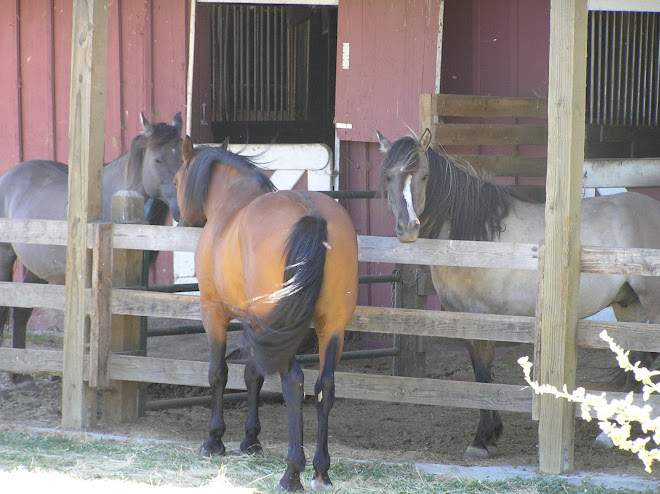 |
|
|
|
Post by fantasykiger on Jun 7, 2009 11:35:56 GMT -5
I have never met Dino' , if you showed me that picture and asked me the color of that horse I would say bay. But I think pictures are deceiving. I am pretty sure Dino has produced dun foals out of non-dun mares, if memory serves me right. Clearily the dun foals got them stripes from somewhere. I think the photo above shows a Dino' with a dirty bum ;D hiding his dorsal.
|
|
|
|
Post by barbhorses on Jun 7, 2009 11:48:10 GMT -5
Dirt doesn't hind dorsal stripes. My grulla mare can be filthy and in a full Utah winter coat and you can still see a clear dorsal stripe and leg barring as well as her big neck and shoulder markings. Dun factor dilutes the base coat. Hence, why the grulla is properly referred to in English as a black dun. Without the dun factor, the horse would just be black. However, with the dun factor, the horse's body is diluted and you can see striping. Dino has no presence at all of any dilution. Neither does the bay foal with counter shading. The perfect example is the zebra dun horse next to the bay with counter shading. You can see that that Kiger has a clear and vivid dorsal with a diluted body. Without the dun factor, the horse would be a bay.
|
|
|
|
Post by DianneC on Jun 7, 2009 11:52:22 GMT -5
Barb horses, its not polite to say what other people's horses are or are not. But I'll ask you if you think Sundance was a dun?
|
|
|
|
Post by barbhorses on Jun 7, 2009 11:58:04 GMT -5
Sorry, but I thought that that is what this thread was about? Guessing what color this foal is. It would be proper to use the parents in regards to guessing what this foal's color is.
Yes, I have always thought that Sundance was a zebra dun.
|
|
|
|
Post by fantasykiger on Jun 7, 2009 14:06:05 GMT -5
Regardless of how evident stripes are on a horse, on whether or not to call them a dun, having a gray dun I can tell you mine shows none. I have to go by what they produce, to say whether or not he they have dun gene  when bred to non-dun horses. |
|
|
|
Post by barbhorses on Jun 7, 2009 19:31:20 GMT -5
That would make perfect sense if Dino was in fact grey. Then again, I have heard many times of grey Kigers that still show dun factor. Dino is a beautiful sooty copper bay that passes that sooty gene onto his offspring which in this foal, has counter shading that gives the false impression of a dorsal stripe. If you look at the edges of the counter shading you will notice no clear edge. It is sooty. Which means, that it is not a true dorsal stripe, but rather counter shading. If you look at the true dun horse that is a bay with the dun dilution factor, you will notice that his body is diluted and he has a very clear dorsal stripe. This is what the other foal lacks. Everything that I have read about the dun dilution factor means that it is not possible for Dino to be a true dun and neither is this foal. That still doesn't take away the fact that he still has gorgeous coloring.
Anyways, I think it is obvious that I don't have much else to contribute, but I highly recommend reading about what makes a true dun horse. Those two links above that I posted would be a great place to start.
|
|
|
|
Post by spanishsagegrullas on Jun 7, 2009 20:46:39 GMT -5
As far as whether the horse is a red dun or a bay-based dun (clearly not a grulla) the best and factual way to tell is to run a coat color test. UCD does them, I believe the web address is www.vgl.ucd.edu. I would say the horse is a bay-based dun, not a red dun. Dino does had an obvious dorsal stripe, and anyone who has ridden behind, beside , or near him can attest to that. Once again, Kimberlee Jones, you astound me with your "proclamations" regarding what you think you know, when you are not as educated as you think you are. The lady at duncentral has some theory, not supported by any one, or anyone interested in doing research, that there is some "Primitive striping gene" that is different than the dun gene. UCDavis is doing research on the dun gene, and has located what appears to be associated markers. It does not seem that they have found the gene itself. So there are lots of theories and thoughts on what constitutes dun. Some people do theorize that just a dorsal stripe is not dun. Most of those theorists have not seen, as I have and other Kiger breeders have, a dorsal only horse produce a foal with significant striping. Dilution is another discussed subject, but when you think about it, if you can see a clear, darker colored stripe on a horse's back, wouldn't that mean that the surrounding coat is lighter, and that would be a dilution? Sooty/countershading, if you all are using them interchangeably, does NOT and never has been understood, by color geneticists, and those other scientists who have used the term and have attributed it to camoflague, to mean any distinctly bordered variation in color. That is exactly the purpose, to create a blended darker upper body with lighter lower body. So the sun does not glint off the topline, and make the animal easy to see by predators. "Counter " (ie against) shading -- countering the effects of direct sunlight. Look it up, why don't you? Ask Dr. Sponenberg, if you care to. Gray horses can also carry the dun gene, since the grey gene only causes the color, no matter what it is, to eventually turn white. How quickly that happens seems to vary by horse and breed. So, not unusual for a grey Kiger to be able to produce a dun, who would start greying as it gets older, which some people call "claybank." Color genetics and theories are really interesting, and since the dun factor is a defining characteristic of the Kiger breed, I think all breeders should be up to date on what it is, how it is inherited, and what the current research is. Try www.dungenes.orgDiane P. |
|
|
|
Post by barbhorses on Jun 7, 2009 21:53:54 GMT -5
Yes, and your opinion is also just that Diane, nothing more. Also, the site I was trying to get is called equinecolor.com which is evidently down. That is the site that uses Dr. Sponenberg's opinion on color. I couldn't find any other website that addressed the counter shading that this foal and Dino is displaying that seemed credible.
Also, a zebra dun IS a bay dun. Just FYI. Once again, the dun gene is a dilution gene. Which is why my black dun aka grulla mare isn't solid black. Which by the way her color genetics is EE aa with no cream gene. Which means she is homozygous for black and her base color is black. If there was a horse that would be a solid black that had a stripe visible in the summer due to fading, it would be her. Yet, she has a clear dun dilution going on and has never been even close to being a solid black due to the dun dilution gene. So your thoughts that Dino that displays no dilution at all in his body coat can somehow be a zebra dun is just nonsense.
|
|
|
|
Post by stormyranch on Jun 7, 2009 23:05:23 GMT -5
WELL!!! My pictures of Dino with his dorsal stripe were in a photo album not on digital so I had to go out tonight and take pictures. This thread IS about trying to figure out what color Keeper is not wheather or not I am lying about Dino being a Dun. But, Kimberly I know you like to be the cause of heated debates. I will not debate this with you. Dino has produced 2 duns out of Palomino mares. 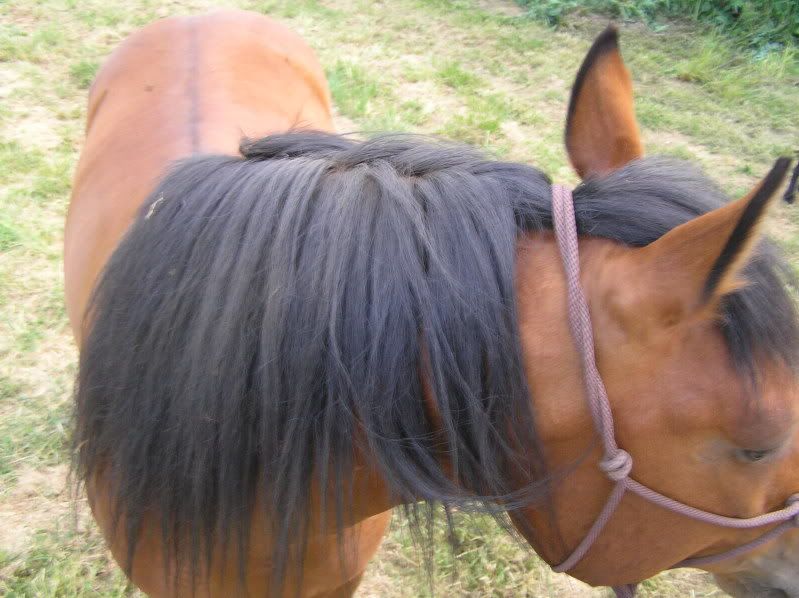 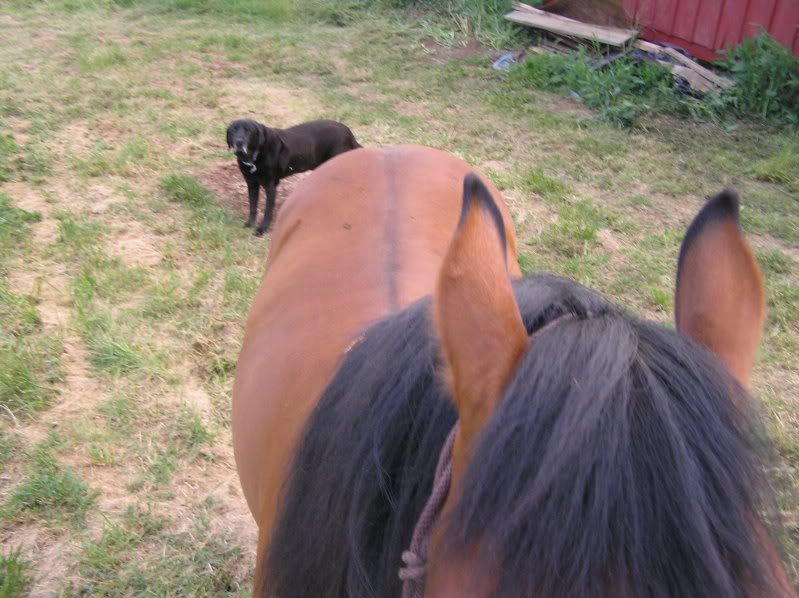  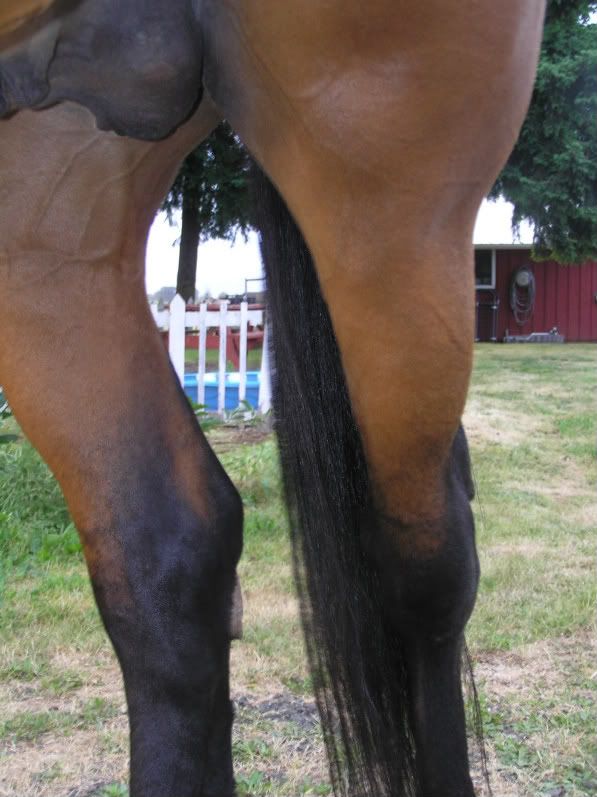 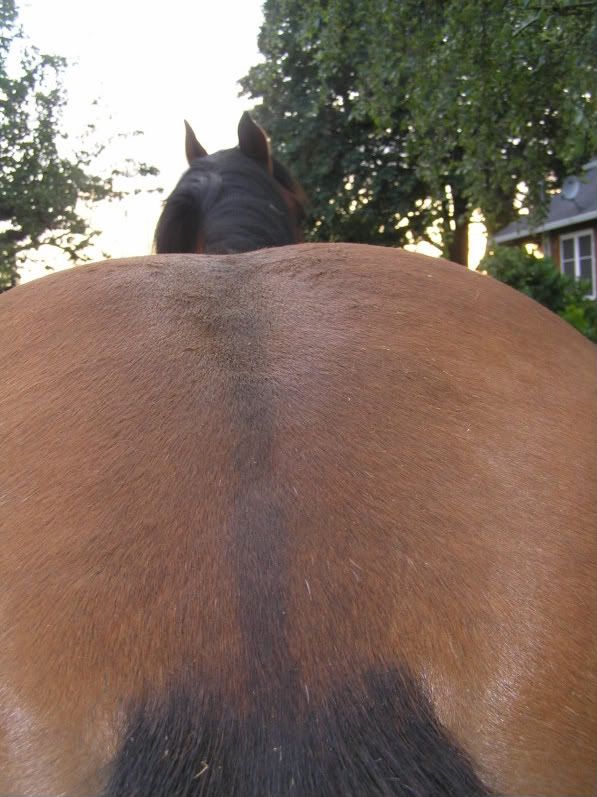 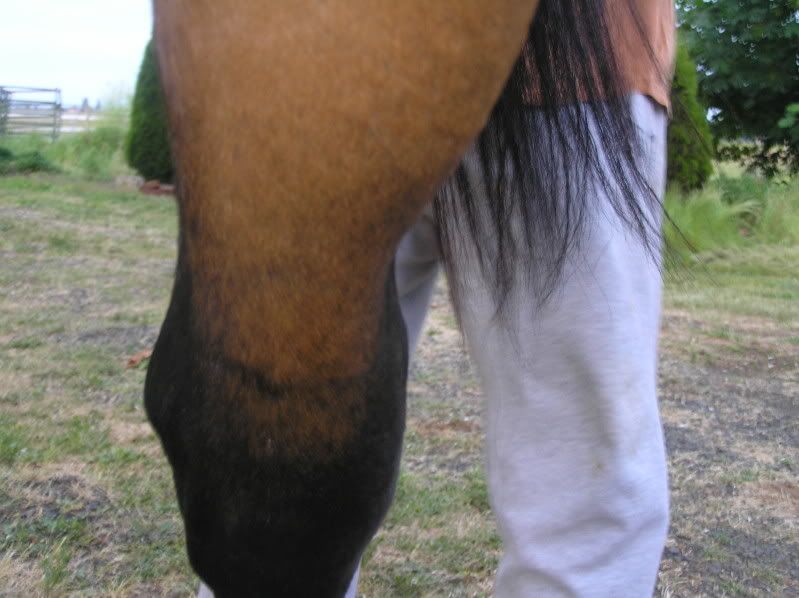 |
|
|
|
Post by spanishsagegrullas on Jun 7, 2009 23:09:51 GMT -5
"So your thoughts that Dino that displays no dilution at all in his body coat can somehow be a zebra dun is just nonsense."
I am so sorry you are having trouble with this concept, Kimberlee. Let me try to explain it to you more clearly: Dino has a clear stripe that runs down his back. It is a dark red color, almost black but not quite, as I recall. You can see the stripe because the rest of his body color is lighter in color than this stripe. Dilution of the coat color results in a color that might be lighter than it would be without the dilution effect. If one can discern that the dorsal is a different color than the body color, and in order to be able to see a dorsal it has to be a different shade, than, by definition, the coat is diluted. I am so sorry that you cannot make sense out of this, but I know no other way to explain it.
"I couldn't find any other website that addressed the counter shading that this foal and Dino is displaying that seemed credible. "
Once again, let me explain a little more fully. Countershading is not a term that is unique to the horse world. Countershading is a commonly used term, and is seen in many species. It is well known in biology and ecology. So, you can surely find many credible sites that address the concept of countershading in coat color.
I do not operate in a vaccuum regarding the dun factor, current theories, and the status of the research and results of testing. I communicate with many people in many different countries about the dun factor, the dun testing offered by UCDavis, and the concerns and thoughts people have. We share many thoughts, ideas, observations. So, the theories that I have explained are not just my own, and not developed in isolation from other thinking and facts, and lastly, certainly not based on a Google search.
Diane P.
|
|
|
|
Post by DianneC on Jun 7, 2009 23:59:57 GMT -5
Thanks Diane P. You took the words right out of my mouth, especially the proclamations part. Kimberlee, its ironic that you chose a Morgan site as they have no idea whatsoever how dun got in their breed. Most likely it was some copper dun being called a bay. To say that a horse is not dun and doesn't have an eel stripe when you haven't seen it in person or even a good photo is rank.
There are many opinions about dun and countershading. Until there is a true scientific and provable explanation then we have to accept it as a mystery on some horses. Yet you insist that your mare, who is almost black is dun diluted but another horse who is almost bay cannot be.
Barb K from dungenes.org has studied duns and duns plus other color genes more than anyone I've ever seen. Even she has a whole page on puzzles.
|
|
|
|
Post by barbhorses on Jun 8, 2009 0:32:04 GMT -5
Yes, Dino is displaying counter shading. He does not have a clear defining dorsal stripe at all nor does his body coat have dilution which would indicate he has the dun dilution factor. Anyways, I keep repeating myself here. It is interesting the debates that go on. If you took Dino's pics over to most any other forum he would be a copper bay with counter shading. I don't see the need why it is so important that he is a dun. Dino has smudging on his "dorsal". He has NO clear defining markings of a dorsal. Dino is a beautiful copper bay with counter shading and is able to produce that counter shading onto his foals. Without a true defining dorsal stripe (which Dino clearly lacks) and also a dilution factor in the body coloring, the horse is not a dun. This is a true zebra dun. Note how CLEARLY his markings stand out. Look at Dino. Note how he completely lacks this clarity of markings. I am not saying he needs to have all of these markings, but this is a good picture of a well marked zebra dun (bay horse with dun factor dilution) to compare Dino to to see how he is not a zebra dun.  Anyways, I realize that I am beating my head against a wall. In the Kiger world, Dino is a zebra dun, in the rest of the world, (just like a grey Kiger is termed a "claybank") he is a copper bay with counter shading. I highly doubt that anyone experienced in color would call Dino a zebra dun. As it is, ALL of us are sitting here guessing as to the color of this foal and me doubting Dino is a zebra dun. No one here is a color expert. In fact, instead of guessing here, go post these pics on the Horse of the Americas board where Dr. S actually looks. He has posted before to what he thinks a horse's color is. I am sure he will do it again. That would be the most helpful to solve the coat color of this foal for you all. The entire point of posting was to help out in the color of this foal. Obviously, this thread has gotten seriously side tracked and instead of people thinking that I am helping, they think I am attacking. So, I have said my peace. There is nothing more to say here on my part. Also, I get into heated debates because I am not one to just follow the "herd". Just for the record, I don't think that a copper bay with counter shading is inferior to a dun. I hope to have both a zebra dun, a copper bay, as well as a gorgeous jet black horse in my barn some day (that is when I finish vet school). |
|